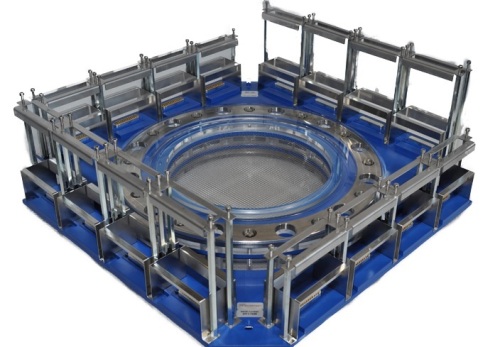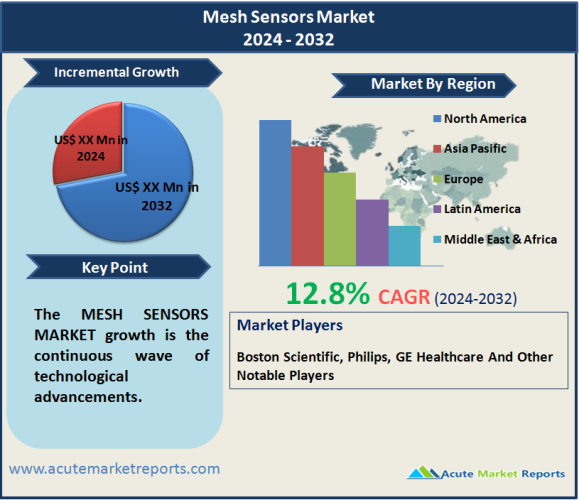
The mesh sensors market is expected to grow at a CAGR of 12.8% during the forecast period of 2025 to 2033, driven by key factors such as technological advancements, increasing demand for smart home solutions, and expanding applications in healthcare. However, the industry faces challenges related to cost and accessibility. The highest revenue in 2024 is attributed to temperature sensors, reflecting their widespread use across industries, while Wi-Fi mesh sensors lead in CAGR during the forecast period, indicating a growing emphasis on seamless connectivity. Battery-powered mesh sensors lead in revenue, while energy-harvesting mesh sensors exhibit the highest CAGR, reflecting a shift towards sustainable and self-sufficient sensor solutions. Competitive trends highlight the strategic positioning of major players like Boston Scientific, Philips, and GE Healthcare, emphasizing collaboration with healthcare providers and a commitment to innovation. Overall, the mesh sensors market is characterized by a balance between established technologies and emerging trends, shaping the future of interconnected sensing solutions across diverse sectors. The collaboration between established players and strategic partnerships with end-users underscores the collaborative nature of the mesh sensors market, where technological innovation converges with practical applications to shape the future of interconnected sensing solutions.
Key Market Drivers
Technological Advancements Propelling Growth
One of the primary drivers fueling the mesh sensors market's growth is the continuous wave of technological advancements. Companies like Boston Scientific, Philips, and GE Healthcare have been at the forefront of innovation, investing significantly in research and development. These endeavors lead to the creation of cutting-edge mesh sensor solutions that cater to diverse applications, ranging from industrial automation to environmental monitoring. For instance, the integration of advanced temperature sensors enables precise data collection in industrial settings, enhancing overall operational efficiency.
Growing Demand for Smart Home Solutions
The increasing demand for smart home solutions is another pivotal driver propelling the mesh sensors market forward. Companies in this domain are actively developing mesh sensor applications for smart homes, incorporating features such as motion sensors, light sensors, and proximity sensors. These innovations contribute to the creation of interconnected and intelligent home ecosystems, fostering convenience and energy efficiency. The strategic partnerships observed in the market align with this trend, as established players collaborate with technology providers to deliver seamless and integrated solutions for modern living.
Expanding Applications in Healthcare
Healthcare emerges as a significant driver for the mesh sensors market, with applications spanning from patient monitoring to environmental sensing within healthcare facilities. Leading companies recognize the potential of mesh sensors in revolutionizing healthcare delivery. Through strategic collaborations with healthcare providers, these companies aim to leverage their technological expertise to enhance patient care. The integration of mesh sensors in healthcare applications facilitates real-time data monitoring, ensuring timely responses to critical situations and improving overall patient outcomes.

Market Restraint
Cost and Accessibility Challenges
Despite the positive trajectory, the mesh sensors market faces a restraint in the form of cost and accessibility challenges. Emerging companies, especially in regions with high growth potential, are actively addressing this concern by focusing on the development of cost-effective mesh sensor solutions. However, the industry still grapples with balancing the need for advanced technology with the imperative of making these solutions accessible to a broader audience. The challenge lies in overcoming the cost barriers and ensuring widespread availability, requiring concerted efforts from industry stakeholders.
Market Segmentation Analysis
Market by Sensor Type: Temperature Sensors Garner Highest Revenue, while Wi-Fi Mesh Sensors Lead in CAGR
The market segmentation based on sensor types reveals a diverse landscape with various sensors catering to specific needs. Temperature sensors, pressure sensors, motion sensors, proximity sensors, light sensors, gas sensors, and other sensors collectively form the foundation of the mesh sensors market. Each sensor type addresses unique requirements, with applications ranging from industrial automation to environmental monitoring. In 2024, temperature sensors stand out as the segment generating the highest revenue, driven by their widespread applications across industries. Simultaneously, Wi-Fi mesh sensors take the lead in CAGR during the forecast period, reflecting the increasing adoption of interconnected devices and the growing emphasis on seamless connectivity. The temperature sensor market, characterized by its maturity, commands substantial revenue, while the Wi-Fi mesh sensor market showcases dynamic growth potential, positioning it as a key player in the future landscape.
Market by Connectivity Type: Bluetooth and Zigbee Mesh Sensors Dominate the Market
Mesh sensors' connectivity types play a crucial role in determining their compatibility and effectiveness in different scenarios. Bluetooth mesh sensors, Zigbee mesh sensors, Wi-Fi mesh sensors, cellular mesh sensors, and other connectivity types provide versatile options for users. While Bluetooth and Zigbee mesh sensors dominate the market in terms of revenue in 2024, Wi-Fi mesh sensors exhibit the highest CAGR during the forecast period. This dynamic suggests a shifting preference toward more robust and high-bandwidth connectivity options.
Market by Application: Industrial Automation applications dominate the Market
Mesh sensors play a pivotal role in industrial automation, contributing to enhanced efficiency and real-time monitoring. In 2024, the industrial automation application segment leads in revenue, showcasing the widespread adoption of mesh sensors in optimizing manufacturing processes and operational workflows. The integration of mesh sensors in manufacturing facilities enables precise data collection, facilitating automation and improving overall operational efficiency. Mesh sensors find significant applications in healthcare, particularly in patient monitoring and environmental sensing. During the CAGR period from 2025 to 2033, the healthcare application segment emerges as the leader in growth, underscoring the increasing importance of interconnected healthcare solutions. Mesh sensors in healthcare contribute to real-time patient monitoring, ensuring timely interventions and fostering advancements in healthcare delivery.
Market by Power Source: Battery-Powered mesh sensors Dominate the Market
Mesh sensors derive power from various sources, including batteries, energy harvesting, and other power sources. Battery-powered mesh sensors, offering portability and flexibility, lead in terms of revenue in 2024. However, energy-harvesting mesh sensors showcase the highest CAGR during the forecast period, indicating a growing emphasis on sustainable and self-sufficient sensor solutions. The choice of power source aligns with specific application requirements and environmental considerations.
North America Remains the Global Leader
In 2024, North America holds the highest revenue percentage in the mesh sensors market. This indicates a strong adoption of mesh sensor technologies in various industries within the region, driven by technological adoption rates and industrial development. Companies in North America leverage mesh sensors for applications such as industrial automation and smart homes, contributing to the region's revenue leadership in 2024. During the CAGR period from 2025 to 2033, the Asia-Pacific region emerges as the leader in growth. This growth is influenced by factors such as increasing industrial development, rising demand for smart home solutions, and a favorable regulatory landscape. The Asia-Pacific region witnesses a surge in mesh sensor adoption across diverse applications, including industrial automation and environmental monitoring, contributing to its leadership in CAGR during the forecast period.
Market Competition to Intensify during the Forecast Period
In the competitive landscape of the mesh sensors market, key players such as Boston Scientific, Philips, and GE Healthcare continue to shape the industry's trajectory. These companies, with established leadership positions, have strategically aligned themselves with healthcare providers to implement mesh sensor technology effectively. The collaboration between technology providers and healthcare institutions aims to combine technological expertise with clinical knowledge, ultimately enhancing patient care. The competitive landscape is marked by strategic partnerships, research and development initiatives, and a commitment to innovation.
Historical & Forecast Period
This study report represents analysis of each segment from 2023 to 2033 considering 2024 as the base year. Compounded Annual Growth Rate (CAGR) for each of the respective segments estimated for the forecast period of 2025 to 2033.
The current report comprises of quantitative market estimations for each micro market for every geographical region and qualitative market analysis such as micro and macro environment analysis, market trends, competitive intelligence, segment analysis, porters five force model, top winning strategies, top investment markets, emerging trends and technological analysis, case studies, strategic conclusions and recommendations and other key market insights.
Research Methodology
The complete research study was conducted in three phases, namely: secondary research, primary research, and expert panel review. key data point that enables the estimation of Mesh Sensors market are as follows:
Market forecast was performed through proprietary software that analyzes various qualitative and quantitative factors. Growth rate and CAGR were estimated through intensive secondary and primary research. Data triangulation across various data points provides accuracy across various analyzed market segments in the report. Application of both top down and bottom-up approach for validation of market estimation assures logical, methodical and mathematical consistency of the quantitative data.
| ATTRIBUTE | DETAILS |
|---|---|
| Research Period | 2023-2033 |
| Base Year | 2024 |
| Forecast Period | 2025-2033 |
| Historical Year | 2023 |
| Unit | USD Million |
| Segmentation | |
Sensor Type
| |
Connectivity Type
| |
Application
| |
End-User
| |
Power Source
| |
|
Region Segment (2023-2033; US$ Million)
|
Key questions answered in this report